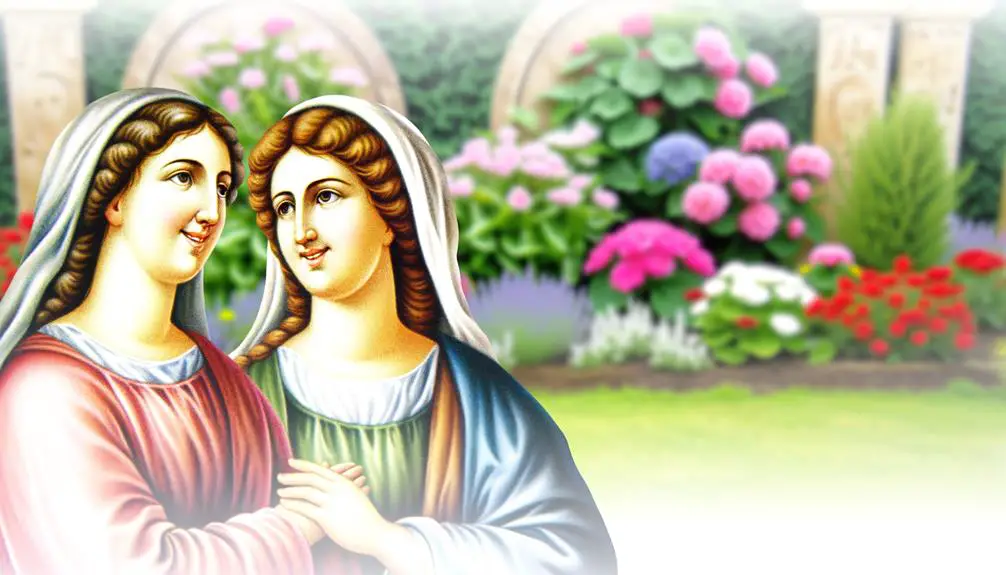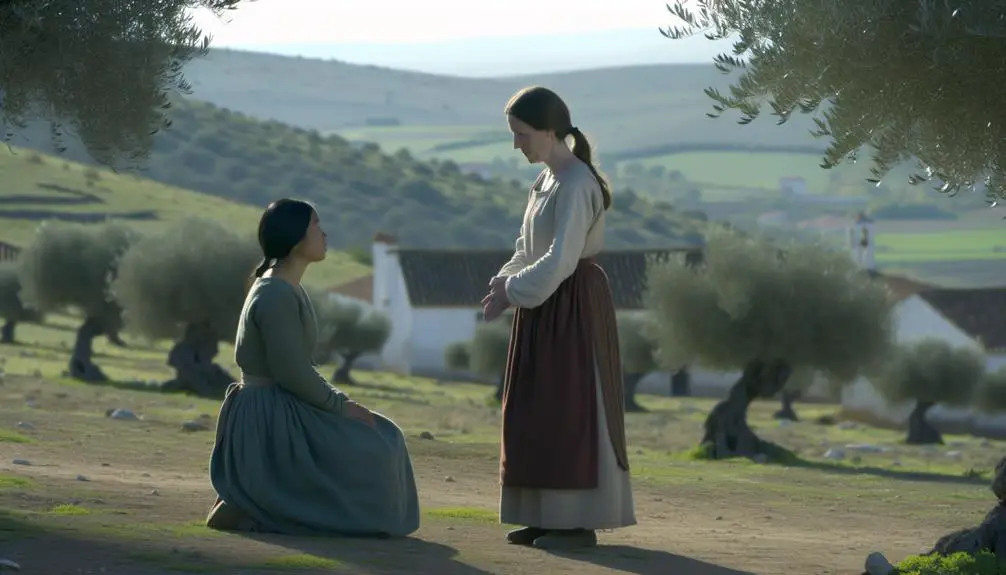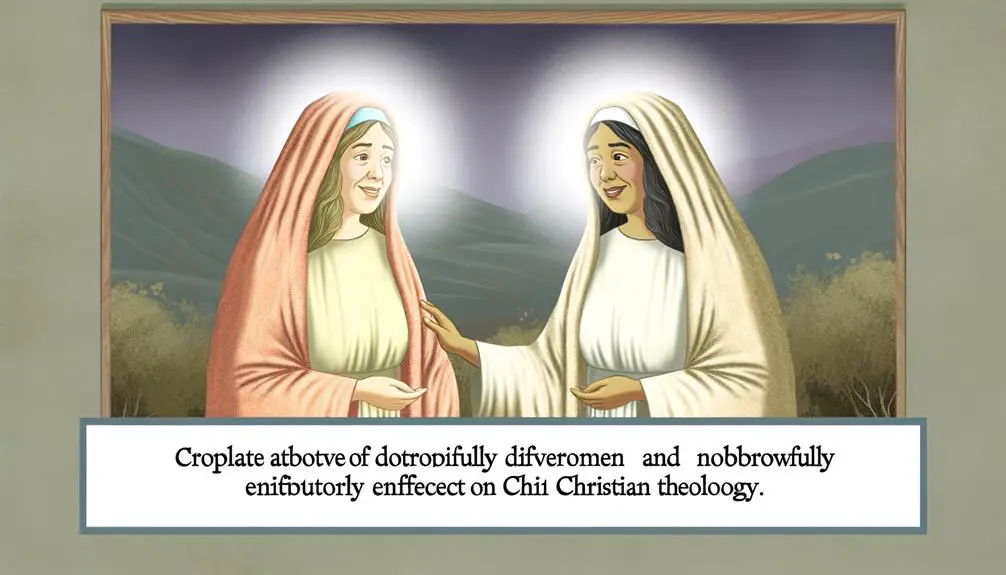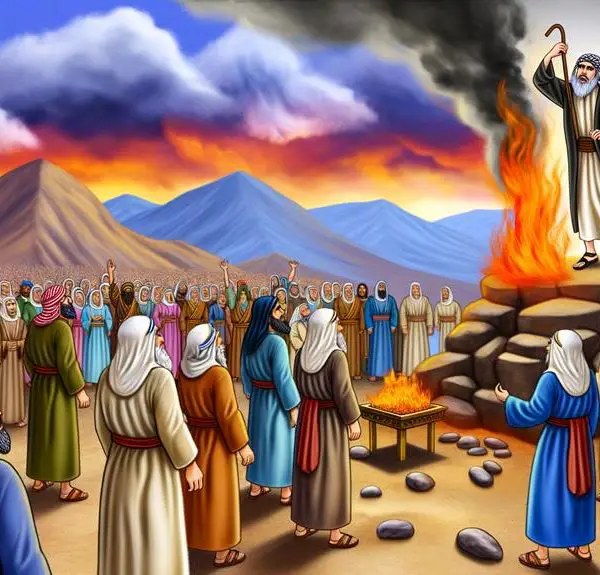Biblical figures Mary and Elizabeth share a profound connection, revealing divine insights that deepen our understanding of faith and prophecy—discover their story.

Elizabeth and Mary Relationship in the Bible
In the Gospel of Luke, you learn about Mary's journey to visit Elizabeth, marking a significant moment of divine orchestration. Despite the challenges of traveling 70-100 miles from Nazareth to Judea, Mary's visit served as a profound act of faith. Upon her arrival, Elizabeth, filled with the Holy Spirit, immediately recognized the messianic significance of Mary's pregnancy—an affirmation that sharply contrasted with Zacharias' disbelief. This encounter isn't just a familial reunion; it symbolizes the merging of prophetic traditions and validates Mary's role, deeply influencing Christian theological perspectives on divine revelation and Mariology. This story's layers of theological insight continue to shape Christian doctrines today.
Key Takeaways
- Elizabeth and Mary were relatives, sharing a familial bond that deepened through their prophetic roles in biblical narratives.
- Their meeting in the Gospel of Luke highlights a mutual recognition and affirmation of their divine roles in the unfolding salvation history.
- Elizabeth, filled with the Holy Spirit, confirmed the divine nature of Mary's pregnancy and blessed her, contrasting with Zechariah's initial disbelief.
- Mary's response to Elizabeth's greeting is the Magnificat, a prophetic hymn of praise emphasizing God's mercy, justice, and fulfillment of promises.
- This encounter is significant in Christian theology, symbolizing the merging of Old and New Testament prophecies and enhancing Marian doctrines.
Biblical Context of Their Meeting

The meeting between Elizabeth and Mary, pivotal figures in the New Covenant, unfolds in the Gospel of Luke, where their encounter is richly imbued with prophetic fulfillment and divine orchestration. As you explore this narrative, consider the broader context of their meeting, particularly the travel hardships and cultural norms of their time.
Traveling in the ancient Near East was fraught with challenges, especially for a young woman like Mary. The journey from Nazareth to the hill country of Judea, possibly covering around 70 to 100 miles, would have been arduous and perilous. You must imagine traversing rough terrains, vulnerable to bandits and natural elements, all the while Mary was in the early stages of her miraculous pregnancy.
Cultural norms also played a significant role in framing this encounter. Women in this period were typically relegated to domestic spheres, and their movements were often restricted. Mary's decision to undertake such a journey underscores the urgency and spiritual significance she attributed to the visit. It reflects a profound act of faith and obedience, resonant with the cultural expectations of piety and family solidarity. Mary's journey not only fulfilled divine prophecy but also aligned with and challenged the societal norms of her time.
Elizabeth's Role and Response
Elizabeth's response upon Mary's arrival, marked by a spirit-filled exclamation, underscores her pivotal role in affirming the divine nature of Mary's conception. This moment, vividly captured in the Gospel of Luke, not only highlights Elizabeth's spiritual receptivity but also contrasts sharply with Zacharias' disbelief when confronted with his own miraculous news. While Zacharias, a priest, doubted the angel's message of his wife's pregnancy, Elizabeth, filled with the Holy Spirit, instantly recognizes and affirms the messianic significance of Mary's unborn child. This profound acknowledgment is not merely a personal reaction but a theological affirmation that reverberates through the narrative of salvation history.
Your understanding of this dynamic is further enriched when considering the cousin dynamics at play. The relationship between Elizabeth and Mary provides a familial framework that emphasizes solidarity and mutual support among women in divine narratives. Elizabeth's role transcends passive kinship; she actively contributes to the unfolding divine plan by reinforcing the truth of the announcement made to Mary. This interplay between disbelief and belief, set within a familial context, underscores the complexity and depth of faith responses in biblical narratives. Elizabeth stands as a beacon of belief, her response encapsulating a pivotal affirmation of faith and prophecy.
Mary's Reaction and Prophecy

Upon hearing Elizabeth's prophetic greeting, Mary's profound response is encapsulated in the Magnificat, a powerful prophecy reflecting her deep theological insight and spiritual maturity. You find in Mary's words a rich tapestry of scriptural allusions and theological themes that underscore her role in salvation history. Her reaction isn't merely personal; it's universally resonant, projecting divine joy and prophetic affirmation.
Mary's Magnificat, as you explore further, is not just an expression of gratitude but a prophetic declaration about God's actions. Her words, 'He has brought down rulers from their thrones but has lifted up the humble,' reveal an acute awareness of social and spiritual reversals central to messianic expectations. This isn't just a spontaneous burst of joy; it's a calculated proclamation, steeped in the prophetic tradition, which Mary articulates with remarkable clarity and foresight.
You observe here a young woman who, despite her humble beginnings, speaks with authority and knowledge of God's covenant. The divine joy she exudes isn't naive optimism but a robust affirmation of her faith in God's promises. Mary's prophecy serves not only as a personal declaration but as a beacon that guides and illuminates the theological landscape of her time.
Significance of Their Encounter
Reflecting on Mary's Magnificat, we can see how her encounter with Elizabeth not only validated her own role but also symbolized the merging of prophetic traditions within their familial bond. This meeting, steeped in spiritual significance, initiated with a joyful greeting that resonates deeply in the narrative. As soon as Mary's greeting reached Elizabeth's ears, the baby leaped in her womb—an emblematic response that underscored the miraculous and prophetic nature of their interaction.
The maternal bond between Mary and Elizabeth, cousins linked by divine intervention, served as a conduit for their mutual reinforcement of faith and prophetic roles. This bond isn't merely biological; it's profoundly theological, reflecting a shared commitment to God's plan. Their encounter, hence, isn't just a family reunion but a divinely orchestrated event that highlights the continuity and fulfillment of God's promises through generations.
This moment of shared joy and spiritual recognition between the two women underscores the importance of communal support and affirmation in nurturing one's vocation. Through their interaction, Elizabeth's encouragement and recognition of Mary's blessed state amplify the significance of Mary's own prophetic song, the Magnificat, reinforcing the themes of joy, fulfillment, and divine orchestration in their lives.
Impact on Christian Theology

The encounter between Mary and Elizabeth profoundly influenced Christian theology, particularly in illustrating the role of women in divine revelation and salvation history. This moment, encapsulated in the Gospel of Luke, underscores the theological significance of their mutual recognition of each other's roles in the unfolding salvation narrative. You see, their interaction not only emphasizes the active participation of women in God's plan but also sets the stage for subsequent theological debates concerning Mary's role, particularly discussions on the Virgin Birth and the Immaculate Conception.
Delving deeper, the doctrinal implications of this encounter extend to the understanding of Jesus' nature as both human and divine. Elizabeth's declaration, "Blessed are you among women, and blessed is the fruit of your womb!" (Luke 1:42), is not merely an acknowledgment of Mary's blessedness but also a theological affirmation of Jesus' divine sonship. This proclamation has fueled extensive discussions and has been pivotal in shaping the Mariological doctrines that underline Mary's unique role in Christian soteriology.
Thus, the narrative of Mary and Elizabeth goes beyond a simple familial greeting; it's a cornerstone for Marian theology and its interconnection with Christological doctrines, making it a critical component of Christian theological discourse.
Frequently Asked Questions
How Were Elizabeth and Mary Related?
You're exploring family dynamics and Biblical lineage without specific context. Elizabeth and Mary were relatives, highlighting intricate familial connections that influence broader narratives and spiritual themes within their historical and religious framework.
Did Elizabeth Have Other Children Besides John?
You're exploring whether Elizabeth had other children besides John, focusing on genealogical context and familial significance. Biblically, there's no mention of other offspring, suggesting John's unique prophetic role in his family's lineage.
How Old Was Elizabeth When She Became Pregnant?
The Bible doesn't specify Elizabeth's exact age, but it highlights her miraculous conception at an advanced age, suggesting she was beyond typical childbearing years, aligning with ancient norms of generational narratives.
Where Did Elizabeth Live During Her Pregnancy?
During her pregnancy, Elizabeth resided in the hill country of Judea, where household dynamics and the significance of visitations played pivotal roles, highlighting themes of divine intervention and prophetic fulfillment in her life.
What Happened to Elizabeth After John's Birth?
After John's birth, Elizabeth's life had a profound impact on her community. Zechariah's reaction—initial disbelief followed by prophetic joy—underscored the miraculous nature of the event, deeply affecting those around them and enhancing communal faith and cohesion.



Sign up